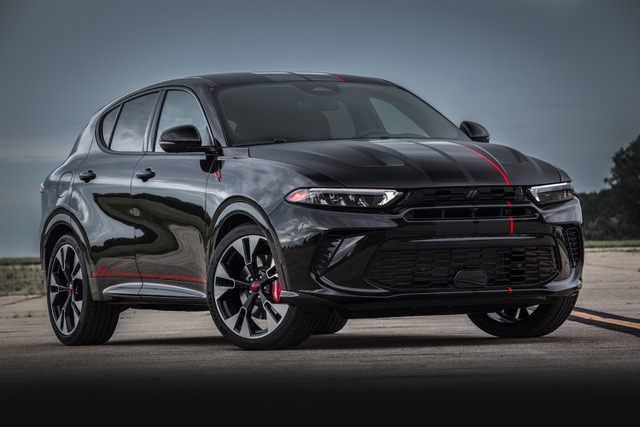The Hudson Hornet debuted in 1951, the Dodge Hornet in 2023. In the interim, the same nameplate has been used on concept cars, pickup trucks and daily drivers.
The most recent was the AMC Hornet. Last made in 1977, the compact sedan and wagon was showcased in movies and dutifully served families and muscle car enthusiasts. It has a loyal following among niche collectors.
For 2024, the new Dodge Hornet returns for its second year as part of a marketing campaign labeled the “Brotherhood of Muscle.”
Available in GT, GT Plus, R/T and R/T Plus trims, the Hornet adds a performance niche to the niche of compact utility vehicles. It has a muscular exterior design and the strongest engine in the segment.
The GT and GT Plus models are powered by turbocharged 2.0-liter, four-cylinder engines producing 268 horsepower and 295 lb-ft of torque and nine-speed automatic transmissions. Combined gas mileage is 24 mpg.
A plug-in hybrid Hornet R/T edition debuted with the 2024 model. It offers up to 33 miles of range on battery power when set to electric mode.
With lots of personality among competitors, the Hornet marks its place as the fastest in the collection of quality choices. It accelerates from 0-to-60 miles per hour in 5.6 seconds and has a top speed approaching 130 mph. All models come standard with all-wheel drive.
The Hornet drives with a combined appeal. It’s immediately comfortable and it has an edginess, perhaps only available in the segment in the Mazda CX-30. But the Hornet is more upscale and more powerful.
South Korean offerings, the Hyundai Kona and Kia Seltos, are value-oriented and exude quirky styling. Tradition points go to the Honda HR-V, the smaller sibling of the top-selling and enduring Honda CR-V. The HR-V stretches the definition of a compact utility vehicle. Chevrolet offers the oddly named Trax.
Sharing a platform and powertrain options with the new Alfa Romeo Tonale, the Hornet assumes the responsibility of its predecessors. It’s handsome like its ancestors but modernized with thin headlights and tail lights, sharply trimmed corners and an aggressive-looking front grille. The interior complements the exterior, with a tidy appearance, a well-placed touchscreen and digital gauges.
Considering its close relationship with Alfa Romeo, the Hornet does have a surprise. It’s also made in Naples, Italy.
Front seating is available in cloth, synthetic leather and leather. Rear-seat passengers travel on a bench seat with adequate space, although door bottoms taper substantially. The Hornet R/T has 22.9 cubic feet of storage behind the rear seats. The GT trim has 54.7 cubic feet of cargo behind the front seats.
Regardless of trim level, the Hornet adds energetic steering and a confident ride to its best-of-segment power. Active lane control, automatic emergency braking, blind-spot monitor and rear parking sensors are standard as two-mode shocks. Twenty-inch wheels and adaptive cruise control are options.
The beginning price ranges vary by about $10,000. The base Hornet GT includes a 10.3-inch touchscreen, Apple CarPlay, Android Auto and power front seats starts at $32,330. The reviewed Hornet R/T with the same features excluding its plug-in powertrain, starts at $42,530.
Available options include heated front seats, a remote start, a Tech Pack with adjustable dampers, Brembo brakes and 20-inch wheels, adaptive cruise control, lane centering, a 360-degree camera system and an automated parking system.
As the newest of the vehicles named Hornet, the current version has its uniqueness. It’s far different from the Hudson Hornet or the AMC Hornet, with one exception. Just like its namesake icons, the new Hornet could build an enduring legacy. It’s 50 years or so years down the road.
James Raia is a syndicated automotive writer in Sacramento. E-mail: james@jamesraia.com












